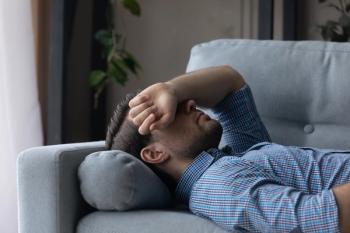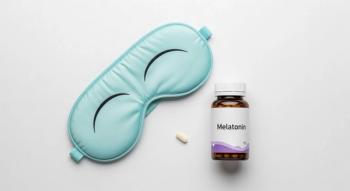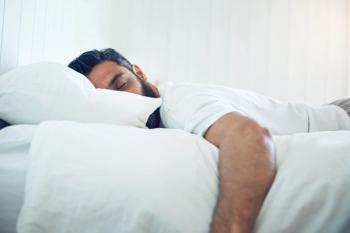
- Vol 39, Issue 12
Beyond Counting Sheep: Helping Patients With Insomnia
Many individuals do not get medical support for insomnia. Here's how you can help.
PSYCHVIEW
Insomnia affects a large segment of the general population, but many individuals do not receive medical support for it, shared Paul Doghramji, MD, and Leslie Citrome, MD, MPH, in a recent PsychView custom video series.
“Research tells us that about one-third of the adult US population has at least 1 symptom of insomnia,” explained Citrome, a clinical professor of psychiatry and behavioral sciences at New York Medical College in Valhalla, New York. “One-third of that one-third meet the DSM-5 criteria for
Getting to the Diagnosis
Unfortunately, many patients seem reluctant to voluntarily discuss their poor sleep with clinicians, Doghramji noted, so it is up to the clinician to begin that dialogue.
“If we are interested in their
Citrome agreed. “They won’t tell you about it because they may think you are not interested, or they have so many other pressing issues on their mind to resolve,” he said. “If they are coming to see you for a very specific problem, they may think that the sleep is kind of incidental to that. So they have to be encouraged from the get-go to tell us about their sleep.”
Citrome includes sleep questions as part of the mental status examination and the overall evaluation. Just like he might ask about a patient’s appetite, he looks to get an idea of how well they are sleeping.
Fortunately, Doghramji noted that there is a new scale to help with sleep assessments: the Insomnia Daytime Symptoms and Impacts Questionnaire (IDSIQ). The IDSIQ is a patient-reported outcome instrument that assesses 14 items within 3 domains: alert/cognition, mood, and sleepiness.1 The IDSIQ is based on the 20-item Daytime Insomnia Symptom Scale, and it has been validated according to US Food and Drug Administration (FDA) guidelines to measure the impact of insomnia on daytime functioning. It requires minimal time, and research has indicated that patients find it easy to complete, making it a potentially useful tool in clinical practice.
“The IDSIQ is a derivation of an older scale and places it in the modern age,” Citrome said. “It helps us get a full understanding of a person’s ability to perform during the daytime with the presumption that they’ve had a good night’s sleep the night before.
“Various other patient-reported outcomes have been used in the past but were not so finely tuned as this one. We have had, for example, the Patient Global Impression and various questions asked about the speed of falling asleep, remaining asleep, and the satisfaction with one’s sleep. That information has been collected for a very long time, but there has not been the same degree of attention on next-day functioning.”
Doghramji is likewise pleased with this instrument. “Patients report not only trouble getting to sleep and staying asleep, but they also report that during the day, they don’t function very well,” he said, noting the importance of assessing and addressing presenteeism. “Here’s a tool that’s developed to specifically assess how sleepy somebody is during the day.”
Comorbidities and Insomnia
Not surprisingly, insomnia accompanies a number of other medical and psychiatric disorders, which can complicate assessment and treatment, the duo noted. Medical comorbidities often include chronic obstructive pulmonary disease, obstructive sleep apnea,
“Insomnia or difficulty with sleep is part of the diagnostic criteria for many psychiatric conditions, but people can actually meet the full diagnostic criteria for insomnia disorder in addition to meeting criteria for, let’s say, major depressive disorder,
“There was an interesting cross-sectional study done of outpatients in Singapore, in which they calculated the percentage of people with major mental disorders who also have DSM-5 insomnia disorder,” Citrome shared.2 “They found 1 of 2 people with major depressive disorder also met the full criteria for insomnia disorder. One out of 4 also had schizophrenia; 1 of 3 had
“As a practicing psychiatrist, I find it very helpful to know if someone has a problem with their sleep,” Citrome added. “I use it as the canary in the coal mine, so to speak. Someone who is doing reasonably well and all of a sudden has trouble sleeping, I think that maybe this is a sign of things to come and I need to be prepared for addressing a potential recurrence of their, let’s say,
Understanding sleep and sleep quality can also help prognosticate how a patient may fare in the future, he added. “We know there’s this bidirectionality,” Citrome said. “It’s incredibly important for me as a psychiatrist to acknowledge that insomnia is associated with a 4-fold relative risk of new-onset major depressive disorder. It’s also a robust predictor of depression relapse.”
Citrome and Doghramji agreed that sleep issues should be continuously assessed. Citrome explained: “Insomnia often persists once the acute depressive episode has essentially resolved itself. I can help patients along with their mood—their concentration. Sometimes, though, the sleep problem persists, and I have to think of something beyond the treatment that I had used to treat their depressive symptoms.”
Psychoeducation and a Good Foundation
Although sleep hygiene alone will not address insomnia, Citrome includes conversations about it with patients. He reminds patients about good habits, including keeping a regular sleep-wake schedule, reducing noise in the bedroom, blocking out light, removing electronic devices from the bedroom, and avoiding daytime napping, alcohol,
Doghramji and Citrome agreed that a shared decision-making process can improve results, so they engage their patients in making treatment decisions from the very start. As part of the history, for instance, they ask about previous attempts to address the problem.
“I ask my patients exactly what they have tried to help themselves sleep better because more often than not, they have already tried something. They have already gone to the drugstore and bought something over the counter,” Citrome said. “I also need to find out if in the past they have received any prescription medicines, which basically fall into 2 categories: those that are FDA approved for insomnia and those that are not and used off-label.”
Citrome also takes the opportunity to educate his patients, shedding light on the ineffectiveness and dangers associated with OTC remedies. For example, the most common OTC drugs include diphenhydramine, which can cause next-day drowsiness.
“That is particularly a problem,” Citrome explained. “Here we have insomnia disorder associated with daytime tiredness because you are not sleeping well. Well, if you are going to use a medication approach that makes you tired at night and fall asleep but still makes you tired the next day, that’s not going to address the next-day functioning that has to be improved. I emphasize the need to be alert the next day and that we can’t use anything with carryover effects.
“Then I have a discussion about what the FDA has approved in terms of insomnia disorder,” he continued, noting the limitations of
“The baggage with both benzos and the Z drugs is the development of tolerance,” he said. “When patients try to stop taking these medicines, they experience rebound insomnia—insomnia much worse than when it all started.
“I also describe how melatonin receptor agonists have also been developed,” Citrome continued. “There’s one in the marketplace. However, it takes a bit of time before it starts to work, and it’s not for everyone. I mention low-dose doxepin, as it’s out there, but basically that’s a repurposing of a tricyclic antidepressant at a lower dose and leveraging its [adverse] effect profile to help someone sleep. Then lastly, I talk about the latest medicines that are available, the orexin receptor antagonists, as offering probably a superior approach to the treatment of insomnia disorder.”
Considering Treatment Options
With new technology and new medications available, clinicians and patients have a number of options to consider.
“The problem I have in my community is that there aren’t enough skilled practitioners of CBT-i, so access may be limited,” Citrome said. To help address the shortage, apps have been developed, including the CBT-i Coach.
“It’s a smartphone app that was developed by the US Department of Veterans Affairs and released about a decade ago, and people do like it,” he said, but he noted that patients “need a little extra help from the clinician in terms of navigating it.”
In addition, Doghramji and Citrome are excited about the new medications known as dual orexin receptor antagonists (DORAs), which work differently from other medications.
Orexin neurons are in the hypothalamus,3 Citrome explained. “They project to various parts in the brain, and they keep us awake. In people with insomnia, they are working overtime. The dual orexin receptor antagonist locks those receptors in the brain and helps the individual fall asleep and remain asleep,” he said. “Basically, it works very different than knocking someone over the head with a sledgehammer with a Z drug or a benzo.”
In addition to a DORA’s mechanism of action being different, Doghramji and Citrome agreed that there are other benefits: They do not deleteriously affect sleep architecture, and long-term use is not associated with tolerance/withdrawal or rebound insomnia.
Many DORAs have been studied for insomnia, Doghramji noted, and 3 are FDA approved. The first that came out was suvorexant, then lemborexant, and finally daridorexant. Unlike other medications, this class of medications was designed to be taken every day, at nighttime.
“They’re not prns,” Citrome added. “They’re not middle-of-the-night drugs. They were designed to be taken 30 minutes or so before falling asleep when you have about 7 hours ahead of you to be asleep....It’s a very different approach than in the past, when you take something to knock yourself out and maybe at 2 in the morning repeat again. This is a much more thoughtful approach: You have insomnia disorder. Here’s how to treat it. Here’s a medicine. You take it every night, and your sleep is better regulated.”
Although DORAs all work similarly, Citrome explained they have different pharmacokinetic profiles with different half-lives, for example. “The most recently approved DORA, daridorexant, has a half-life of about 8 hours or so,” he said. “It’s the shortest. When you look at the curve—the pharmacokinetic curve that is the concentration curve over time—you reach a maximum concentration in about an hour or two, and then the concentration drops off.”
Concluding Thoughts
Ultimately Doghramji and Citrome agreed that the most important thing is to address sleep with patients. “I think we need to have a conversation with our patients routinely about their sleep, and we need to set aside enough time to discuss it,” Citrome said. “You do need to spend that time. It often gets ignored.
“And let’s do something about it,” he implored. “Because the spillover effect into all their other conditions and their daytime function is substantial.”
References
1. Hudgens S, Phillips-Beyer A, Newton L, et al.
2. Seow LSE, Verma SK, Mok YM, et al.
3. Soya S, Sakurai T.
To watch this PsychView custom program, visit
Articles in this issue
about 3 years ago
Current Treatments for Cannabis Use Disorderabout 3 years ago
The Importance of Cherishing the Older Adults in Your Lifeabout 3 years ago
Dementia in the Newsabout 3 years ago
Eight Best Practices for Medical Malpractice Defenseabout 3 years ago
Psychopharmacology Conference Offers New Research, Prescribing Tipsabout 3 years ago
Use of Antipsychotics: Risks of Tardive Dyskinesiaabout 3 years ago
On Transienceabout 3 years ago
Beyond “Bad Behavior”: ADHD in Clinical PracticeNewsletter
Receive trusted psychiatric news, expert analysis, and clinical insights — subscribe today to support your practice and your patients.

















